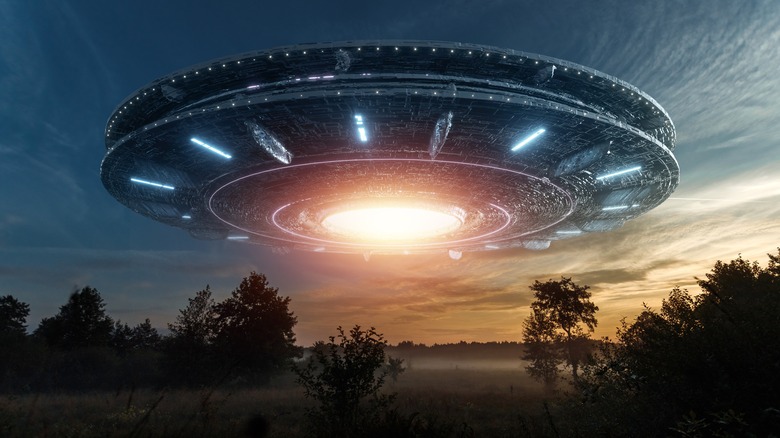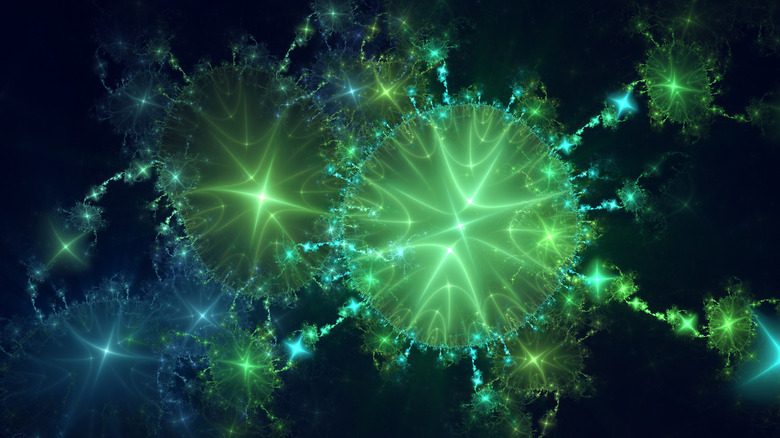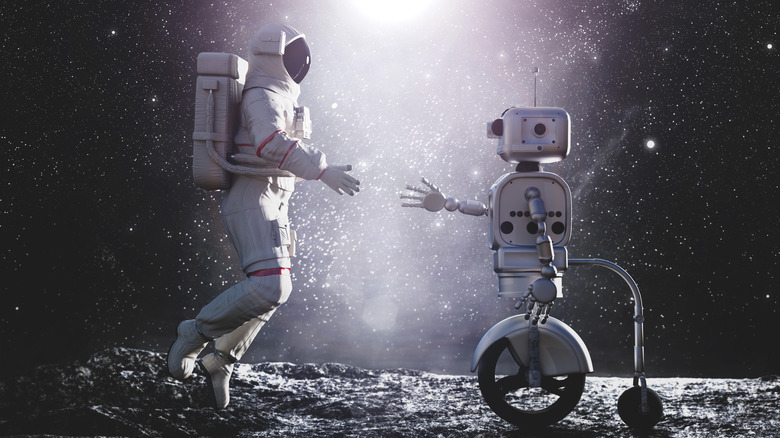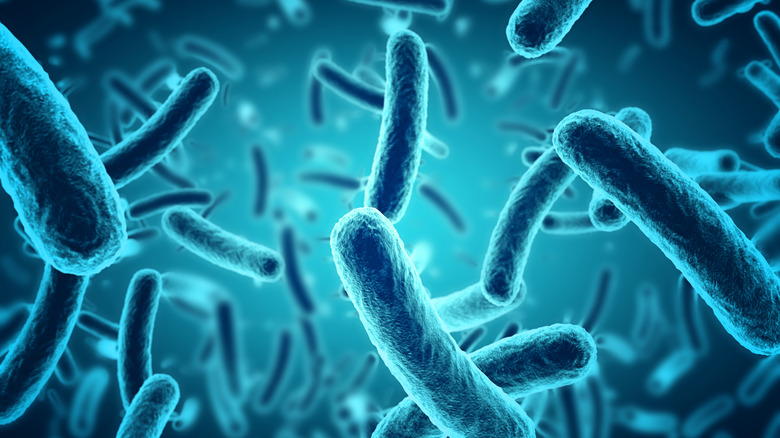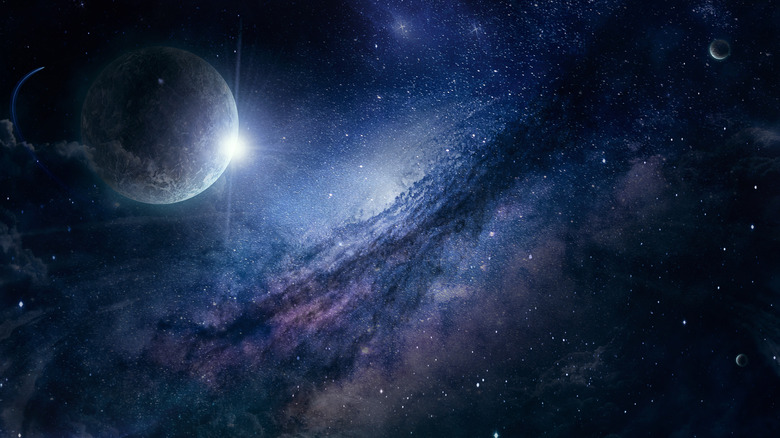Scientists Have Interesting Thoughts About What Aliens May Look Like
So aliens, right? They're gangly predators who sprout tentacles from their skulls, and each tentacle has like 20 gnashing mouths on it. Or they're giant protoplasmic space blobs color-shifting in the sun as they hurtle spaceship-less to Earth to coat the planet in cosmic goo. Or you know, they're basically humans but with pointy ears, severe eyebrows, and a tendency to say, "Live long and prosper." The point is: aliens take the shape of human fears and dreams. They also reflect a storyteller's narrative goals in literature, films, TV, etc. So rather than use fiction to envision alien life, we should turn to real researchers.
But even amongst researchers, there's disagreement about the appearance of aliens. By current estimates, there are between 100 and 400 billion stars in our galaxy, the Milky Way (per Space.com), but only one Earth and one example of so-called intelligent life. So what do we look for? As NASA has cataloged, we've discovered plenty of exoplanets — planets outside our solar system — but no evidence of aliens. But would we even recognize aliens if we found them? Should we scour the skies for evidence of advanced spacefaring civilizations who've encased their own stars in energy-harnessing Dyson spheres, as Science Focus says? Or should we check for biological rather than technological signatures of life in the composition of gases of atmospheres, like astrobiologists at NASA? In the end, we've got as many visions of "alien" as we have methods for finding them.
They might look like us
Imagine you're an astronaut. You touch down on an alien world, the door slides open, and boom: aliens that look nearly human walk up to you. They're bisymmetrical, bipedal, maybe have silver eyes instead of brown or blue, and maybe have some underarm hair. They've got throats and mouths that produce sounds similar to ours. You don't know what the aliens are saying, but they're definitely intelligent.
Believe it or not, this is exactly what some researchers believe: We live in a universe of rubber-headed humanoids, ala "Star Trek." But far from being just a droll or unimaginative take on all possible forms of alien life, there's some sound reasoning behind this assertion, as the Independent outlines. On Earth, similar environmental pressures in wildly different species produce similar evolutionary results, a phenomenon known as convergent evolution. Bats and dolphins, for instance, both developed echolocation in response to needs produced by their respective environments, as Science explains.
So on another planet with comparable atmosphere, gravity, distribution of elements, etc., why wouldn't biological evolution follow a similar course to Earth? If you want flight, there's only so many options. If you want to swim, how about fins? Zoologist Arik Kershenbaum on Quanta Magazine extends this rationale to social behaviors, too, citing group bonding activities like singing and dancing. So sure, alien humanoids might not be as whacky as incorporeal soul devourers orbiting a black hole, but they might do a decent jig.
They might be totally alien
On the completely opposite side of things, there's the argument, "Aliens would be alien — how could they possibly be remotely like us?" This perspective, adopted by master educator and astronomer Carl Sagan, embraces the inherent weirdness of the cosmos. As NPR continues, it presumes that our one, single evolutionary track on this one, single planet could be not representative of the other planetary life, even taking convergent evolution into account. Taking Earth as the example — there's only one example, after all — we've got unique animals like sloths, elephants, platypuses, octopuses, and more. Why wouldn't life on other planets produce such similarly forking paths of biological characteristics?
As Big Think explains, such outcomes might depend on ergodicity: the ability to make statistical predictions of systems. Zooming molecules in a cup of coffee, for example, display very predictable behavior that allows us to know exactly how the cup of coffee will change over time. But how about something as complicated as biological evolution in an interdependent planetary biome? Biologist Stuart Kauffman says no. In fact, he goes so far as to define "life" as a mechanism of change capable of taking many, many forms. Rewind the clock of Earth again and again, and evolution will proceed in a different way each time — it will display a different path dependence. Thinking back to how many extinction events happened on Earth, outlined on World Atlas, this isn't an unreasonable assertion.
Aliens might be robots
Here's a simple question for you: Has humanity ever been to Jupiter? That's a big no. We haven't bodily made it past the moon. Space really takes a toll on the human body: radiation exposure, confinement to a small space, a lack of gravity, microbe-contaminated equipment, etc., as NASA explains. After all, we evolved to stay put on the surface of Earth. All the rest of our knowledge of space comes from telescopes like the Hubble and James Webb Space Telescope, probes to planets like Jupiter, and rovers on rocky planets like Mars. Notice a pattern? Yes: robots and machines.
If we ever actually forge forth into that great black void of the cosmos and become truly spacefaring, the first alien explorers we come across might not be biological aliens but mechanical ones. In a meeting of tech and tech, little robo-arms might stretch out to shake little robo-hands. In fact, some researchers think that the most realistic way for a fragile, meat-form humanity to explore the cosmos is through little, microchip-sized, carbon foam "starchips." Those starchips would be small and light enough to travel 20% of the speed of light and could reach our closest neighboring star, Alpha Centauri, in 20 years, as Scientific American describes. Our current rocket tech would take 18,000 years, per Science. So barring some method of space travel we're not aware of, wouldn't it make sense that another biological race might also send machines into space instead of themselves?
They might be microbes
Yes, bacterial aliens would be a bit underwhelming. That is, unless they're giant space bacteria with tons of thrashing ganglia facing off against human fighter pilots shooting pew-pew lasers, right? But, bacterial aliens are still enough to get researchers excited, as CNN describes. Mars, especially — being so close to us and comparatively easy to explore — has been the subject of lots of investigation regarding bacterial life, both ancient and current, as Phys.org outlines. At the very least, if microbial aliens are all we've got, we at least have evidence that life has developed and is capable of developing on other worlds. Humanity might be ahead of the curve by 3.7 billion years if this is the case, per the Smithsonian. However, alien bacteria would still provide a bit of hope in case we primates ever bite the apocalyptic big one.
But short of thrusting a spade into alien soil and examining it for evidence of fossilized microbes, how could we ever discover tiny, single-celled organisms on planets that are light years away? Enter astrobiology, a branch of science dedicated to detecting the presence of "biomarkers" on other planets, as discussed on the National Center for Science Education (NCSE). Biological life, even only single-celled life, alters the composition of a planet's atmosphere, particularly its methane and oxygen content. In fact, this already happened on Mars and was likely responsible for cooling the planet off and killing its chance at developing further multi-cellular life, per Space.com.
They might be incomprehensible
Finally, alien life might be so different from humanity that it's practically incomprehensible. Take the aliens like those in H.G. Wells' 1898 classic "War of the Worlds." As Lit2Go reads, they had eyes like "two luminous disks," but they were still eyes. The alien mouth was a "lipless brim," but it was still a mouth. We said at the beginning of this article to dispense with fictional visions of aliens. Wells' aliens get a mention just to point out that even the most bizarre depictions of biological life are still just that: identifiably biological life composed of cells, organs, limbs, internal fluids, etc. What about aliens that are so alien we can't even identify them as life?
Sites like ScienceDaily describe alien life as potentially biological, yes, but composed of different elements than humanity, needing different kinds of energy and having entirely different metabolic processes. ListVerse mentions aliens composed of plasma or gas clouds arranged in patterns complex enough to be intelligent. ScienceAlert says that stars might play host to one-dimensional, sentient cosmic superstrings. From here we move into realms of even more extreme speculation. That's okay though, because as Science puts it, our search for life might be "too myopic" and may require a bit more creativity. Or if the theory of panspermia is correct — alien life was seeded on Earth by an asteroid collision in the distant past, per New Scientist — humans might be the most alien creatures around.
